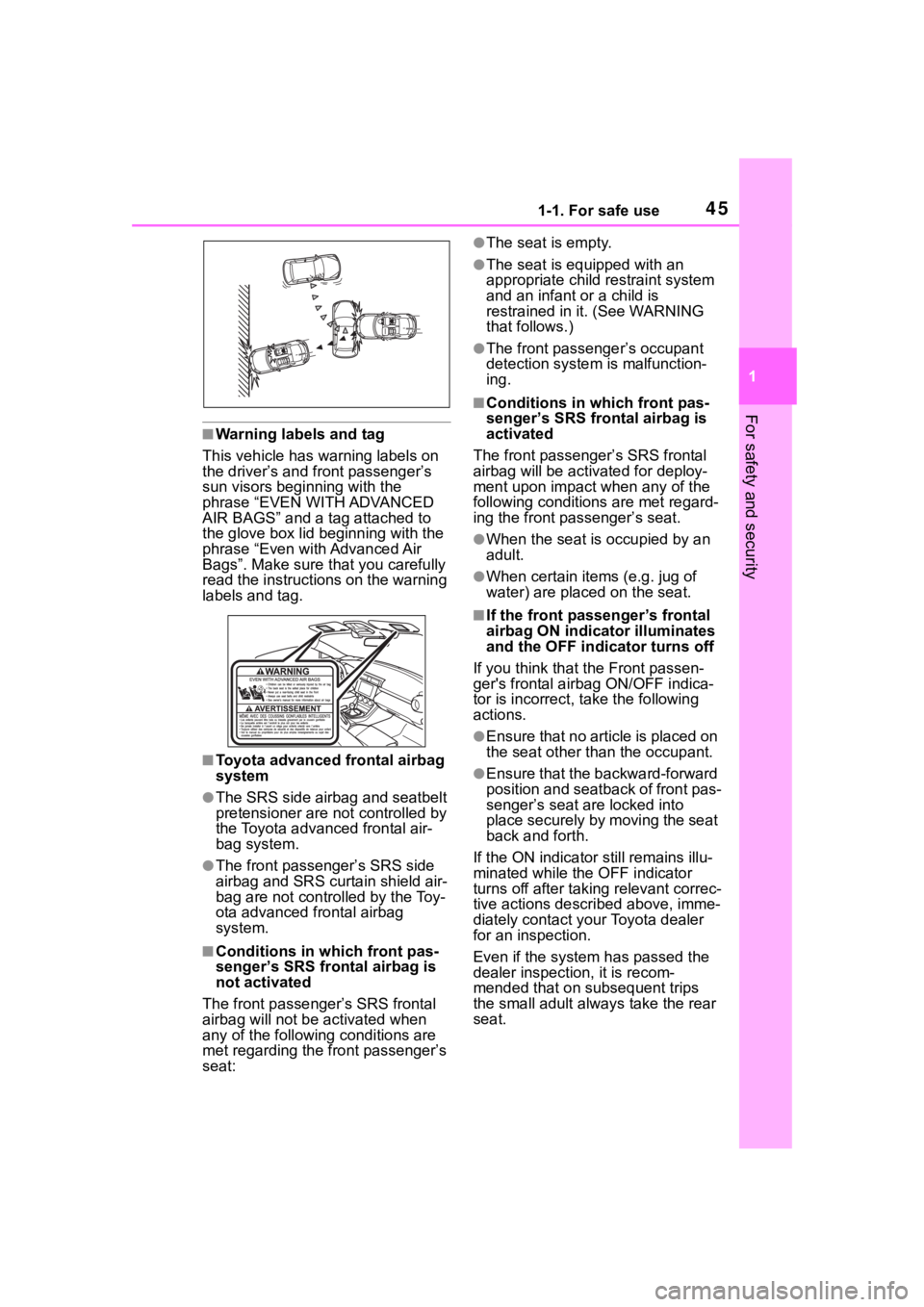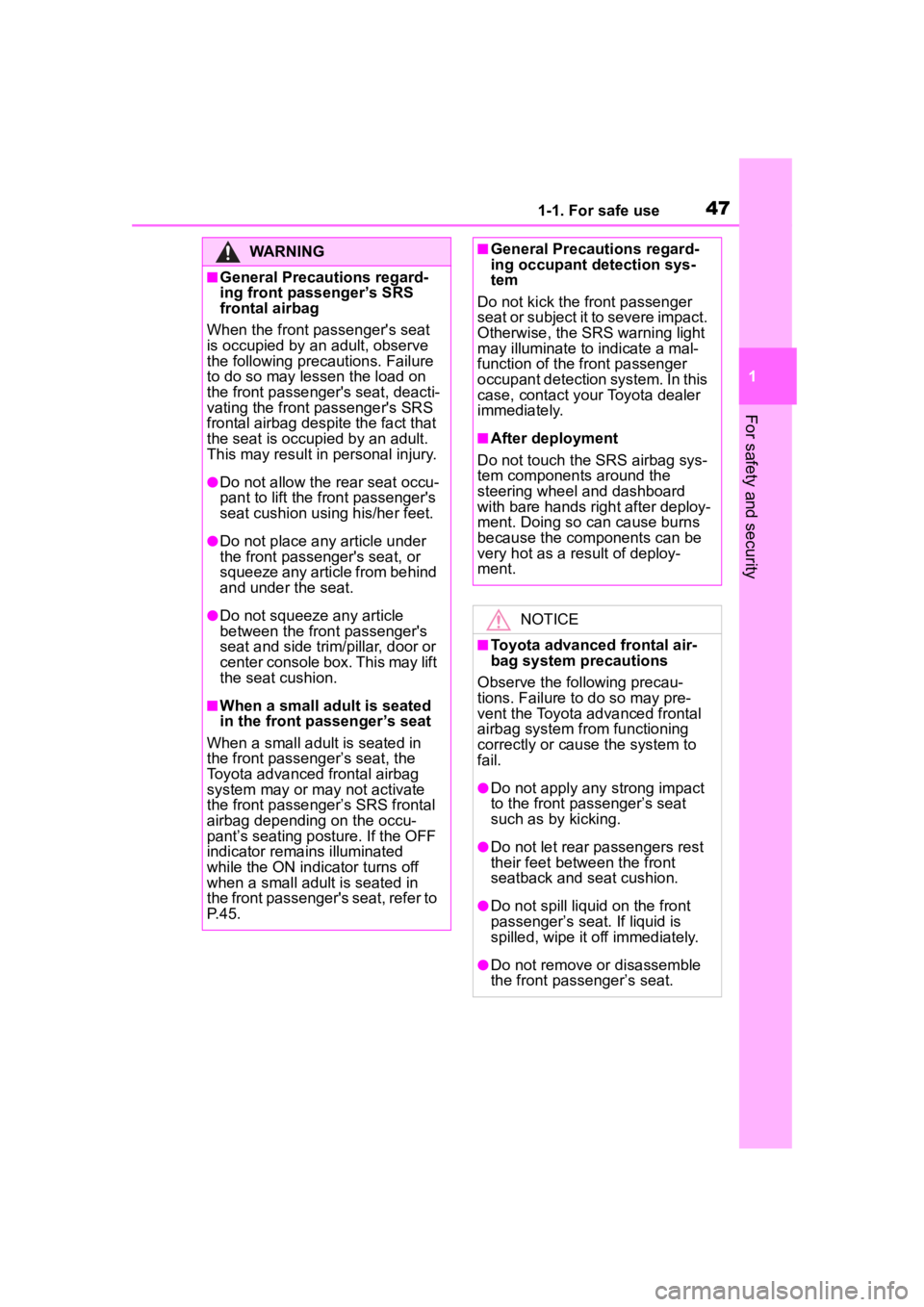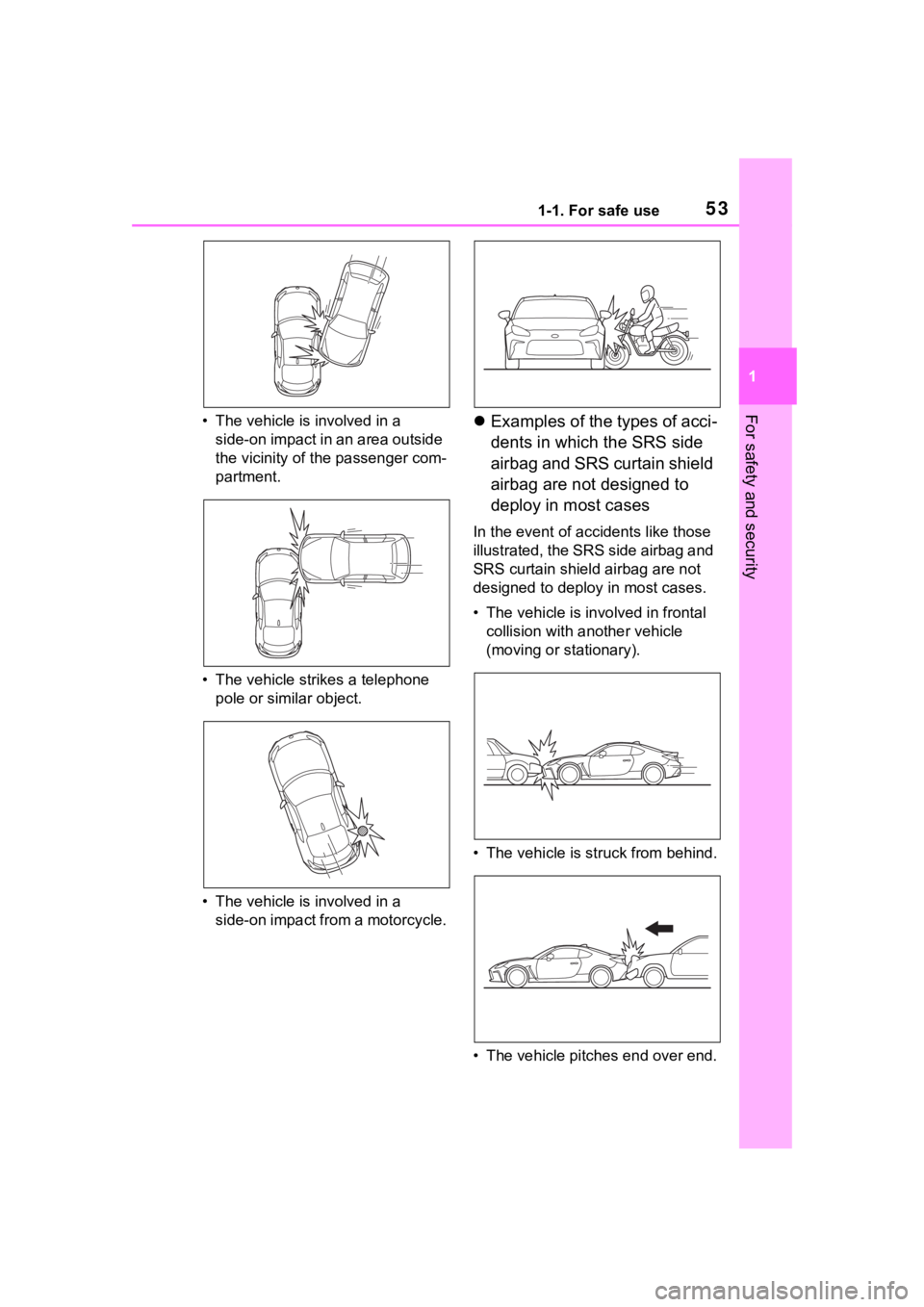2023 TOYOTA 86 ECU
[x] Cancel search: ECUPage 45 of 449

451-1. For safe use
1
For safety and security
■Warning labels and tag
This vehicle has warning labels on
the driver’s and front passenger’s
sun visors beginning with the
phrase “EVEN WITH ADVANCED
AIR BAGS” and a tag attached to
the glove box lid beginning with the
phrase “Even with Advanced Air
Bags”. Make sure that you carefully
read the instructions on the warning
labels and tag.
■Toyota advanced frontal airbag
system
●The SRS side airbag and seatbelt
pretensioner are not controlled by
the Toyota advanced frontal air-
bag system.
●The front passenger’s SRS side
airbag and SRS curtain shield air-
bag are not controlled by the Toy-
ota advanced frontal airbag
system.
■Conditions in which front pas-
senger’s SRS frontal airbag is
not activated
The front passenger’s SRS frontal
airbag will not be activated when
any of the following conditions are
met regarding the front passenger’s
seat:
●The seat is empty.
●The seat is equipped with an
appropriate child restraint system
and an infant or a child is
restrained in i t. (See WARNING
that follows.)
●The front passenger’s occupant
detection system is malfunction-
ing.
■Conditions in which front pas-
senger’s SRS frontal airbag is
activated
The front passenge r’s SRS frontal
airbag will be activ ated for deploy-
ment upon impact when any of the
following conditions are met regard-
ing the front passenger’s seat.
●When the seat is occupied by an
adult.
●When certain items (e.g. jug of
water) are plac ed on the seat.
■If the front passenger’s frontal
airbag ON indicator illuminates
and the OFF indicator turns off
If you think that the Front passen-
ger's frontal airb ag ON/OFF indica-
tor is incorrect, take the following
actions.
●Ensure that no article is placed on
the seat other than the occupant.
●Ensure that the backward-forward
position and seatback of front pas-
senger’s seat are locked into
place securely by moving the seat
back and forth.
If the ON indicator still remains illu-
minated while the OFF indicator
turns off after taking relevant correc-
tive actions descr ibed above, imme-
diately contact your Toyota dealer
for an inspection.
Even if the system has passed the
dealer inspection, it is recom-
mended that on subsequent trips
the small adult alwa ys take the rear
seat.
Page 47 of 449

471-1. For safe use
1
For safety and security
WARNING
■General Precautions regard-
ing front passenger’s SRS
frontal airbag
When the front passenger's seat
is occupied by an adult, observe
the following precautions. Failure
to do so may lessen the load on
the front passenger 's seat, deacti-
vating the front passenger's SRS
frontal airbag despite the fact that
the seat is occupied by an adult.
This may result in personal injury.
●Do not allow the rear seat occu-
pant to lift the front passenger's
seat cushion using his/her feet.
●Do not place any article under
the front passenger's seat, or
squeeze any article from behind
and under the seat.
●Do not squeeze any article
between the front passenger's
seat and side trim/pillar, door or
center console box. This may lift
the seat cushion.
■When a small a dult is seated
in the front passenger’s seat
When a small adult is seated in
the front passeng er’s seat, the
Toyota advanced frontal airbag
system may or may not activate
the front passenger’s SRS frontal
airbag depending on the occu-
pant’s seating posture. If the OFF
indicator remains illuminated
while the ON indi cator turns off
when a small adult is seated in
the front passenger's seat, refer to
P. 4 5 .
■General Precautions regard-
ing occupant detection sys-
tem
Do not kick the front passenger
seat or subject it to severe impact.
Otherwise, the SRS warning light
may illuminate to indicate a mal-
function of the front passenger
occupant detection system. In this
case, contact your Toyota dealer
immediately.
■After deployment
Do not touch the SRS airbag sys-
tem components around the
steering wheel and dashboard
with bare hands right after deploy-
ment. Doing so can cause burns
because the components can be
very hot as a result of deploy-
ment.
NOTICE
■Toyota advanced frontal air-
bag system precautions
Observe the following precau-
tions. Failure to do so may pre-
vent the Toyota advanced frontal
airbag system from functioning
correctly or cause the system to
fail.
●Do not apply any strong impact
to the front passenger’s seat
such as by kicking.
●Do not let rear passengers rest
their feet between the front
seatback and seat cushion.
●Do not spill liquid on the front
passenger’s seat. If liquid is
spilled, wipe it o ff immediately.
●Do not remove or disassemble
the front passenger’s seat.
Page 48 of 449

481-1. For safe use
■SRS side airbag
The SRS side airbag is stored in
the door side of each front seat
seatback, which bears an “SRS
AIRBAG” mark.
In a moderate to severe side
impact collision, the SRS side
airbag on the impacted side of
the vehicle deploys between the
occupant and the door panel
and supplements the seatbelt by
reducing the impact on the
occupant’s chest and waist. The
SRS side airbag operates only
for front seat occupants.
■SRS curtain shield airbag
Your vehicle is equipped with a
SRS curtain shield airbag sys-
tem that complies with the Fed-
eral Motor Vehicle Safety
Standard (FMVSS) No. 226.
The SRS curtain shield airbag
NOTICE
●Do not install any accessory
(such as an audio amplifier)
other than a genuine Toyota
accessory under the front pas-
senger’s seat.
●Do not place anything (shoes,
umbrella, etc.) under the front
passenger’s seat.
●Do not place any objects
(books, etc.) around the front
passenger’s seat.
●Do not use the front passen-
ger’s seat with the head
restraint removed.
●Do not leave any articles on the
front passenger’ s seat or the
seatbelt tongue and buckle
engaged when you leave your
vehicle.
●Do not put sharp object(s) on
the seat or pierce the seat
upholstery.
●Do not place a magnet near the
seatbelt buckle and the seatbelt
retractor.
●Do not use front seats with their
backward-forward position
adjuster and seatback adjuster
not being locked into place
securely. If any of them are not
locked securely, adjust them
again. For adjusting procedure,
refer to P.119.
■When using the front passen-
ger’s seat
Observe the following precautions
as it increase the load on the front
passenger's seat and not work
properly.
●Do not install any accessory
such as a table or TV onto the
seatback.
●Do not allow the rear seat occu-
pant to place his/her hands or
legs on the front passenger's
seatback, or allow him/her to
pull the seatback.
SRS side airbag and SRS
curtain shield airbag
Page 49 of 449

491-1. For safe use
1
For safety and security
on each side of the cabin is
stored in the roof side (between
the front pillar and a point over
the rear seat). An “SRS AIR-
BAG” mark is located at the top
of each center pillar.
In a moderate to severe side
i m p a c t c o l l i s i o n , t h e S R S c u r t a i n
shield airbag on the impacted
side of the vehicle deploys
between the occupant and the
side window and supplements
the seatbelt by reducing the
impact on the occupant’s head.
In a rollover, SRS curtain shield
airbags on both sides of the
vehicle deploy between the
occupant and the side window
and supplement the seatbelt by
reducing the impact to the occu-
pant’s head.
In an offset frontal collision, SRS
curtain shield airbags on both
sides of the vehicle deploy
between the occupant and the
side window and supplement
the seatbelt by reducing the
impact to the occupant’s head
and chest.
■Operation
The SRS side airbag and SRS
curtain shield airbag can func-
tion only when the engine switch
is in ON.
The following airbags deploy
independently of each other
since each has its own impact
sensor.
Driver’s SRS side airbag
Front passenger’s SRS side
airbag
SRS curtain shield airbag
(right-hand side)
SRS curtain shield airbag
(left-hand side)
Therefore, they may not both
deploy in the same accident.
Also, the SRS side airbag and
SRS curtain shield airbag
deploys independently of the
driver’s and front passenger’s
SRS frontal airbags in the steer-
ing wheel and instrument panel.
For the locations of the sensors
and control modules, refer to
P. 2 9 .
■After deployment
After the deployment, the SRS
side airbag immediately starts to
deflate. The time required from
detection of an impact to defla-
tion of an SRS side airbag after
deployment is shorter than the
blink of an eye.
The SRS curtain shield airbag
remains inflated for a while fol-
lowing deployment then slowly
deflates.
The SRS side airbag and SRS
curtain shield airbag deploy
even when no one occupies the
seat on the side on which an
impact is applied.
When the SRS side airbag and
SRS curtain shield airbag
Page 51 of 449

511-1. For safe use
1
For safety and security• The angle of vehicle tip-up is marginal or the skidding vehicle’s
tires hit a curbstone laterally.
• An offset frontal collision that is
severe enough to deploy the front
airbag.
Examples of the types of acci-
dents in which it is possible
that the SRS side airbag and
the SRS curtain shield airbag
will deploy.
It is possible that the SRS side and
curtain shield air bags will deploy if
a serious impact occurs to the underside of your vehicle. Some
examples are shown
in the illustra-
tion.
• Hitting a curb, edge of pavement or hard surface
• Falling into or jumping over a
deep hole
• Landing hard or vehicle falling
Examples of the types of acci-
dents in which the SRS side
airbag is unlikely to deploy.
There are many types of collisions
which might not necessarily require
SRS side airbag deployment. In the
Page 53 of 449

531-1. For safe use
1
For safety and security• The vehicle is involved in a side-on impact in an area outside
the vicinity of the passenger com-
partment.
• The vehicle strikes a telephone pole or similar object.
• The vehicle is involved in a side-on impact from a motorcycle. Examples of the types of acci-
dents in which the SRS side
airbag and SRS curtain shield
airbag are not designed to
deploy in most cases
In the event of accidents like those
illustrated, the SRS side airbag and
SRS curtain shield airbag are not
designed to deploy in most cases.
• The vehicle is involved in frontal
collision with another vehicle
(moving or stationary).
• The vehicle is struck from behind.
• The vehicle pitches end over end.
Page 55 of 449

551-1. For safe use
1
For safety and security
Front impact sensor
• Right-hand side
• Left-hand side
Airbag control module (includ-
ing impact sensor and rollover
sensor)
Frontal airbag module
• Driver’s side
• Front passenger’s side
Knee airbag module
• Driver’s side
Side impact sensor
• Center pillar left-hand side
• Center pillar right-hand side
• Forward of rear wheel house
left-hand side
• Forward of rear wheel house right-hand side
• Door left-hand side
• Door right-hand side
Side airbag module
• Driver’s side
• Front passenger’s side
Curtain shield airbag module
• Right-hand side
• Left-hand side
Seatbelt pretensioner
• Driver’s side
Seatbelt pretensioner and
adaptive force limiter
• Front passenger’s side
Seatbelt buckle switch
• Front passenger’s side
Front passenger’s occupant detection system sensors
Front passenger’s frontal air-
bag ON and OFF indicator
All related wiring
■SRS warning light
Have the system inspected by your
Toyota dealer i mmediately if the
SRS warning light illuminates.
WARNING
■SRS warning light
If the warning light exhibits any of
the following conditions, immedi-
ately stop the vehicle in a safe
place, and consult a Toyota
dealer. Unless a technician
checks and repairs the system as
needed, the seatbelt pretension-
ers and/or the SRS airbag may
not operate properl y in the event
of a collision, which may result in
injury.
●Flashing or flickering of the
warning light
●No illumination of the warning
light when the engine switch is
first turned to ON
●Continuous illumination of the
warning light
●Illumination of the warning light
while driving
Page 57 of 449

571-1. For safe use
1
For safety and security
WARNING
■Front passenger occupant
classification system precau-
tions
Observe the following precautions
regarding the front passenger
occupant classification system.
Failure to do so may cause the
occupant classifi cation system to
not function correctly, resulting in
death or serious injury.
●Wear the seat belt properly.
●Do not apply excessive force to
the seat.
●Do not put sharp object(s) on
the seat or pierce the seat
upholstery.
●Do not put objects under the
front passenger seat.
●Do not use a seat accessory,
such as a cushion or seat cover,
that covers the seat cushion
surface.
●Do not spill liqui d on the front
passenger seat. If liquid is
spilled, wipe it off immediately
and dry the seat. If the SRS
warning light illumi nates, dry the
seat until the warning light turns
off. If the SRS warning light
stays on even when the seat
has dried, do not allow anyone
to sit on the front passenger
seat and have the system
checked by your Toyota dealer.
If the SRS warning light does
not illuminate, check that the
airbag ON/OFF indicator light
works properly. If the indicator
light does not work properly, do
not allow anyone to sit in the
front passenger’s seat and have
the system inspected by your
Toyota dealer.
●Do not remove or disassemble
the front passenger seat. Also,
do not replace or modify the
seat upholstery or foam inside
the seat.
●Do not install any accessory
(such as an audio amplifier)
other than a genuine Toyota
accessory under t he front pas-
senger’s seat.
●Do not place a magnetized
items near the seat belt buckle.
●Never install a rearward facing
child seat in the front passen-
ger’s seat even if the front pas-
senger’s SRS frontal airbag is
deactivated. Be sure to install it
in the rear seat in a correct
manner. Also, it is strongly rec-
ommended that any forward
facing child seat or booster seat
be installed in the rear seat, and
that even children who have
outgrown a child restraint sys-
tem be also seated in the rear
seat. This is because children
sitting in the front passenger’s
seat may be killed or severely
injured should the front passen-
ger’s SRS frontal airbag deploy.
Toyota believes that the rear
seats are the safest place for
children.
●If luggage or electronic devices
are placed on the front passen-
ger seat, the OFF indicator may
turn off and the ON indicator
may illuminate. If this occurs,
the front passenger’s airbag
may deploy during a collision. If
this is not desirable, remove the
luggage or electronic devices
from the front passenger seat.